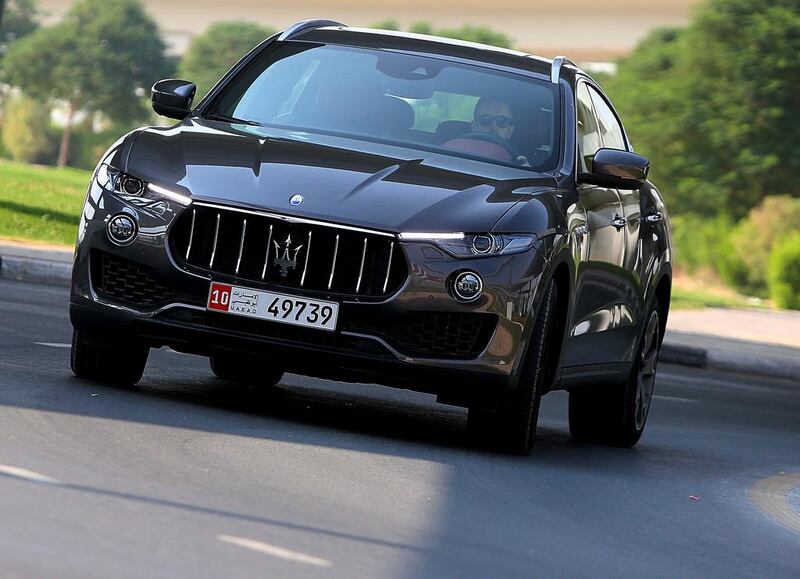In the rush to join the burgeoning, lucrative market for crossover SUVs, many manufacturers seem to have forgotten the ethos behind a segment of vehicles primarily based on car platforms. Instead of a car with some off-road capability, the driving populace is all too often presented with a scaled-down four-wheel drive with reduced dune-bashing potential that also can’t compete with its fully road-going brethren. A jack of all trades, master of none, more or less.
Enter the Levante, quite probably the most important model in the marque’s 102-year history. OK, so it may not be about to overtake the likes of Toyota or Volkswagen at the top of the motoring-sales tree, but no longer will the trident-emblazoned Italians be restricted to comparatively niche sports cars and coupés. The Levante, based on Maserati’s sedan platform, is unashamedly aimed at gobbling up sales.
The first thing that you notice about the Levante is its gaping, basking-shark-esque grill. It looks mighty mean, from the front at least. Mean as in fellow motorists will dive out of your way when confronted with its sight in their rear-view mirrors long before you have to consider anything as uncouth as flashing its scowling bi-xenon headlamps. The rear is a little more generic-Japanese-crossover, but certainly in the Levante S variant that I’m driving, the four tailpipes give you a good clue that this isn’t a dull proposition.
It’s a rare thing when a production car looks better than its concept version, but the Levante has even managed that when viewed against the Kubang, which originally debuted five years ago at the Frankfurt motor show.
It’s perfectly capable of trundling around in a relatively polite manner, until “Sport” mode is detonated. Press the button once, and the exhaust fires out extra evilness, rattling with Italian sports-car intent at all the right high-rev junctures and roaring on change-downs as if it’s huffing and rebuking you for making it slow down. Employ the same button for a second time and the sports suspension kicks in, lowering the Levante onto its haunches. It’s a smart dual level of control.
By the opposite token, the off-road settings raise ride height by up to 40 millimetres, more than enough to negotiate modestly rough ground without a second thought. Taking such a luxury wagon for the full desert treatment might result in the loss of some bodywork, mind you – I wasn’t foolhardy enough to try.
The Levante S’s 430hp twin-turbo 3.0L V6 has already been seen in the Ghibli. It wrings out an impressive amount of power for a V6, with the top torque of 580Nm available at a mere 1,750rpm, so you don’t have to wait long to truly get going. And at 5.2 seconds for the 0-to-100kph sprint, it has the capacity to embarrass competitors such as the Porsche Cayenne S off the lights, going on to hit 264kph, partly thanks to its lightweight construction, using widespread aluminium. The “regular” Levante is 80hp down on power and 0.8 seconds slower to 100kph, by way of comparison.
In an age of electric-assisted steering so light that you can navigate with your pinkie fingers – and end up in a ditch if you sneeze – the Levante’s hydraulic version is a joy. It has great feel and purchase; you’re never in danger of forgetting the round thing in your hands is connected to the round things in contact with terra firma. That’s not the only thing that makes it feel like a sports car in a way that almost every direct competitor has thus far failed to capture. Solid handling is aided by what Maserati claims is the lowest centre of gravity in class, and the picture is completed by an enveloping yet non-claustrophobic interior (trimmed in eye-arresting red leather in my test model). Brakes are fearsomely efficient, too.
You have to look fairly hard to find faults. The unwieldy flappy paddles make reaching behind the left-hand one to operate the indicators a little tricky. And the itsy-bitsy centre console looks like it should be sat atop a secret compartment, but in reality is so shallow that it’s only good for storing smartphone-sized devices. Plentiful compensation comes via the levels of standard kit. That features adaptive front lights, remote start and all manner of driver-assist gizmos (including adaptive cruise control, stop-start technology, blind-spot alerts, lane-departure and forward-collision warnings, plus rear and surround-view cameras, displayed on the 8.4-inch touch screen). The driver’s seat neatly electronically retracts when you stop the engine to aid clambering out (and, later, back in again).
With trim options by Italian fashion house Ermenegildo Zegna and rumours of a V8 in future model years, it seems custom-made for the Middle East. Is this the most vital Maserati ever? The big picture suggests a resounding yes. Named after a warm, Mediterranean wind, the Levante is, fittingly, a real breath of fresh air.
aworkman@thenational.ae





